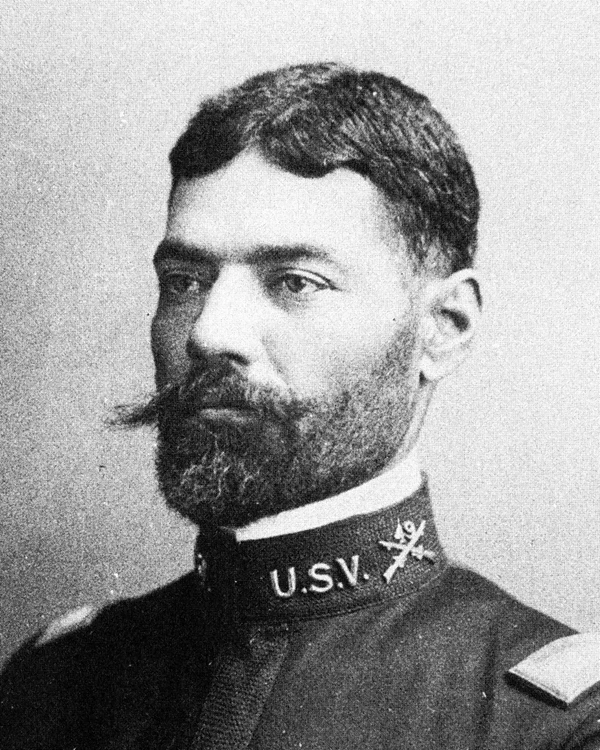Last updated: March 29, 2024
Person
Edward L. Baker Jr.

National Archives
Edward Lee Baker, Jr., was born on December 28, 1865, in Platte River, Wyoming, near Fort Laramie. Baker was the son of a white French father and a Black American mother. He grew up with his family in eastern Wyoming where he learned horsemanship and roping skills. Along with learning the skills of a frontiersman Baker had a fondness for education. He learned French from his father and later studied Spanish, Russian, and Chinese.
On July 27, 1882, at the age of 16, Baker enlisted in the Ninth U.S. Cavalry. During this enlistment he was promoted to trumpeter. Baker reenlisted on August 25, 1887, in the Tenth U.S. Cavalry. While in the Tenth he held various positions including chief trumpeter, quartermaster sergeant, and eventually sergeant major, the highest enlisted rank in a regiment.
Baker traveled with the Tenth Cavalry from Western forts to Tampa, Florida, to await transport to Cuba during the Spanish American War. On the morning of July 1, 1898, Sergeant Major Baker and the rest of the Tenth Cavalry took up their positions around San Juan Heights in Cuba. The Tenth Cavalry along with the First Cavalry and the First Volunteer Cavalry, the Rough Riders, held the far right of the American line that hot, humid morning. Their position was in tall grass along the San Juan River.
The Spanish troops were entrenched on San Juan Hill and Kettle Hill firing down on the Tenth’s position. The Spanish had found the range of the cavalry, and their rifle fire began to take a serious toll. Baker later wrote in his journal about this time, recounting, “the atmosphere seemed perfectly alive with flying missiles from bursting shells overhead, and rifle bullets, which seemed to have an explosive effect.”
Walking up and down the line of the Tenth’s position talking to the troops, Baker reassured them while bullets whizzed by. As Baker made his rounds, he heard a groan and saw Private Lewis Marshall of C Troop wounded and struggling face down in the San Juan River. Baker ignored the advice of other soldiers who told him it was too dangerous to try to save Marshall. Baker pulled Marshall from the water and carried him to safety. After carrying Marshall to safety, Baker alerted the regimental doctor to attend to Marshall’s wounds. Marshall survived thanks to Baker’s actions.
Baker joined the rest of the Tenth Cavalry in their fighting up the San Juan Heights. During the battle, Baker was wounded by shrapnel in his left side and left arm. He continued picking his way through barbed wire entanglements on his way to the summit. He later wrote that the troopers “advanced rapidly…under a galling, converging fire from the enemy’s artillery and infantry.” Finally, Baker and the remaining members of the Tenth U.S. Cavalry reached the summit and forced the Spaniards to retreat.
On July 3, 1902, Baker received the Medal of Honor for his gallantry on July 1, 1898, as a member of the Philippine Scouts. His Medal of Honor citation reads, “Left cover and, under fire, rescued a wounded comrade from drowning.”
Baker retired from the military on January 12, 1910, with a total of 28 years of service. He served in the Ninth and Tenth U.S. Cavalry as well as the Tenth U.S. Volunteer Infantry, Forty-ninth U.S. Volunteer Infantry, and the Philippine Scouts.
On August 26, 1913, Baker died at the age of 47 in San Francisco. He was buried at Angelus Rosedale Cemetery in Section 3, Lot 130, Grave 2 SE in Los Angeles, California.
